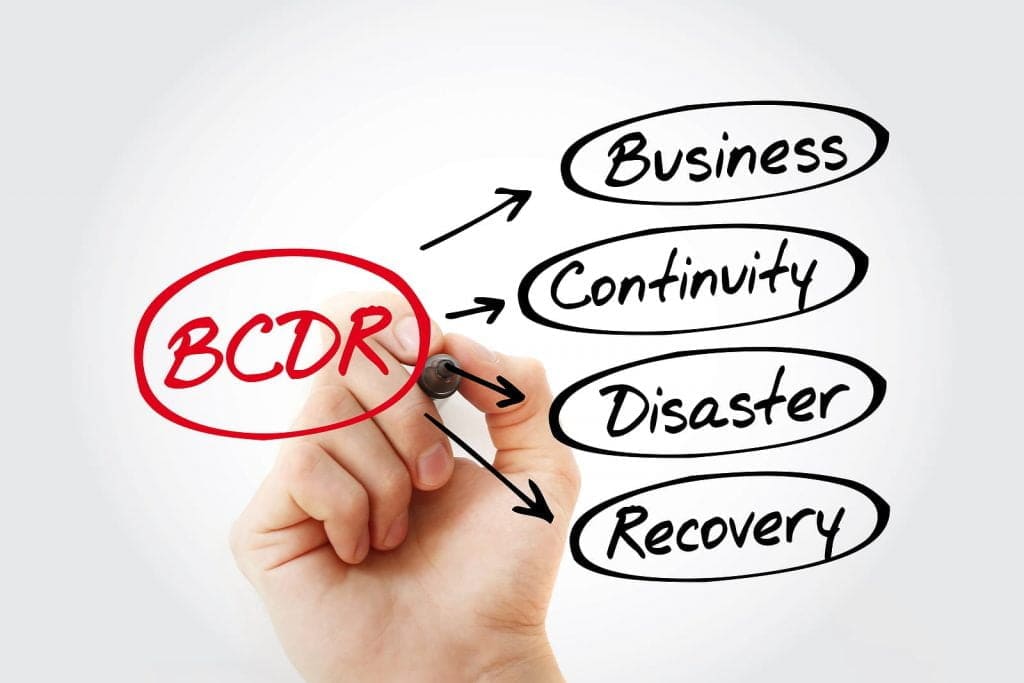Many people get confused between business continuity and disaster recovery. Business continuity planning and disaster recovery both address potential business interruptions. These two disciplines exist to minimize the impact that a catastrophic event can have on a business’s ability to deliver its products and services reliably. While both disciplines are important and even similar in some aspects, they are not the same. There are key differences between business continuity vs. disaster recovery (BCP vs DR), and those in leadership or emergency planning will benefit from understanding what these are.
BCP vs DR
Let’s start with a high-level comparison of the difference between business continuity and disaster recovery. Business continuity planning (BCP) is concerned with keeping all essential functions of an organization going when there is a significant disruption to any part of the organization, including IT systems, essential infrastructure, people, and premises. Disaster recovery (DR) is usually only concerned with the IT and technology infrastructures that support critical business functions. DR is aimed at restoring these critical technology-based systems and services in an emergency after a major event stops them from working. This often involves switching services from the primary site to an alternative location, then switching back again once the emergency is over. Disaster recovery is often considered to be a subset of business continuity.
Consider a holiday booking company that takes orders both online and over the telephone. Both rely on IT systems hosted on the company’s premises. Disaster recovery preparations could include having back-up IT systems in another location, with the data backed up to it several times a day. If the primary IT systems fail, then users could rely on the back-up systems. Business continuity arrangements would, of course, include this but also extend to non-IT issues. For example, making preparations for staff to work from home if they were unable to get into the office for any reason.
The importance of business continuity and disaster recovery
Business continuity planning and disaster recovery are both vitally important disciplines for any organization. If any business tries to cope with a disaster without having any advanced plans in place, then the impacts can be catastrophic. The most common impact is on finances. A business will lose income for every day that it can’t deliver its products and services. Financial losses increase until normal service is resumed. The losses can be so significant that they force the business to make tough decisions, such as cutting staff numbers. If important data is lost, then there can be serious impacts on the ability of the organization to stay in business.
Business continuity planning and disaster recovery planning (BCP and DRP) can help companies to minimize the consequences of a catastrophic event. They can also provide peace of mind by making employees and stakeholders feel more comfortable about being able to respond to disasters.
Similarities between business continuity and disaster recovery
Business continuity planning and disaster recovery planning are often done in isolation. However, whilst the two disciplines are not the same, they overlap in some areas and work best when developed together. In particular, there are many similarities between BCP vs DRP when considering the steps that should be followed to develop effective business continuity and disaster recovery plans. Here are some of the similarities between them:
- Both are proactive strategies that help a business prepare for unexpected significant events.
- Both disciplines take a pro-active and pre-emptive approach, seeking to minimize the effects of the events before they occur, instead of having to react without any forethought or preparation.
- Businesses can use both to prepare for a range of different types of disasters, including pandemics, natural disasters, criminal acts, cyber-attacks, and major technology failures.
- Both require regular review and updates to ensure they continue to be aligned with the organization’s goals, the threat landscape, and the operating environment.
- Both require regular testing to prove the effectiveness.
Differences between BCP and DR
Taking a more detailed look at business continuity vs disaster recovery will highlight some of the differences between the two disciplines. From this, it should be clear that businesses need to understand what is a business continuity and disaster recovery plan so that they can be sufficiently prepared for any disaster.
- Business continuity focuses on keeping normal business activities operational during a disaster, while disaster recovery focuses on restoring data access and IT infrastructure after a disaster. In other words, BCP is concerned with continuity of operations, and DR is concerned with recovery.
- Business continuity and disaster recovery each have different goals. Effective business continuity plans limit operational downtime, whereas effective disaster recovery plans limit the impact of technology failures. Addressing both with aligned business continuity and disaster recovery plans is the best way for organizations to prepare for disastrous events.
- A business continuity strategy aims to ensure that the day to day business activities can continue to operate during a crisis, even if that means working from different locations or using different technologies and systems, or with reduced capacity in some areas. A disaster recovery strategy focuses on restoring the normally used technologies and systems as quickly as possible.
- Some organizations include disaster recovery plans as part of their overall business continuity plans. Disaster recovery plans should be capable of execution in their own right, even if there is no business continuity plan.
Business Continuity & Disaster Recovery – How they differ. A summary.
The related disciplines of business continuity and disaster recovery are key elements of any crisis management strategy. Both are important for the ongoing continuity of any business. Creating effective business continuity and disaster recovery plans requires analytical and problem-solving skills and flexibility in decision-making to assess potential threats and determine how to proactively mitigate them. Strong written and verbal communication skills are essential for communicating the outputs from business continuity planning and disaster recovery planning and training staff in how to use them during a crisis.
But business continuity and disaster recovery are not the same things. It is important that organizations recognize the similarities and differences of BCP vs DRP, then apply an appropriate level of skilled resources to create and test effective and interrelated BCP and DR plans to give the organization the confidence that it will be able to continue in business whatever the event.
FAQ
A: Business continuity refers to the ability of an organization to continue its operations and deliver products or services during and after a disruptive event. It involves planning and implementing strategies to ensure the availability, resilience, and recoverability of critical business functions.
A: Disaster recovery focuses on the specific actions and processes an organization takes to recover its IT infrastructure, systems, and data after a significant disruptive event. It involves restoring and resuming operations as quickly as possible to minimize downtime and mitigate the impact of the event.
A: The primary goal of business continuity is to maintain continuous business operations and minimize the impact of disruptive events. It ensures that essential business functions can continue or be quickly restored, enabling the organization to serve its customers and meet its obligations.
A: The primary focus of disaster recovery is to restore IT infrastructure, systems, and data after a disruptive event. It involves having backup and recovery mechanisms in place to recover data, rebuild systems, and resume operations with minimal downtime.
A: Business continuity and disaster recovery are closely related and complementary. Business continuity plans encompass broader strategies to ensure overall organizational resilience, while disaster recovery plans focus specifically on recovering IT infrastructure and systems. They work together to ensure the organization can continue operating and recover from disruptive events effectively.

